Performance Max Hacks
Written by Zoey Reading
Read our latest blog on optimising Performance Max Campaigns in 2024!
For anyone that didn’t brave the test of performance max when it was first rolled out, you may have been shocked when your smart shopping campaigns were automatically upgraded to performance max in the last month.
The new campaign type is an automated goal-based campaign that utilises machine learning to serve ads to the most relevant audience to maximise campaign performance. Whilst we’ve seen performance gains for a range of clients, we have also struggled with some of the shortfalls of the campaign type for both optimising and reporting.
As performance max has been rolled out, we’ve uncovered a few hacks that can help with the limitations around optimising and reporting.
Performance max hack 1 – View display placements
As performance max is eligible to serve across any google network (search, shopping, YouTube, display, maps and discovery), you may see fluctuations in your impressions and clicks. We’ve had instances where performance has changed dramatically week-on-week with impression volume, assuming google has chosen to serve the ads more on the display network that week, but with no report to show us this.
There is now a predefined report in the interface where you can see where your ads are actually showing across the display network.
To view this, you can go to predefined reports > other > performance max placements
Here, you can see where your ads are showing:
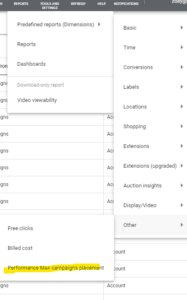
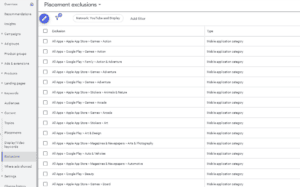
While the column availability is limited, you can see impression volume and where ads are serving.
Performance max hack 2 -Exclude display placements
Now if you’ve freaked out about the number of apps your ads are visible on or are concerned about a huge number of impressions on one placement then do not fear. You’ll be pleased to know, there is a way you can exclude placements for performance max.
Whilst you can’t exclude them at campaign level, you can create account-level placement exclusions.
To do this, in the Google Ads interface navigate to content > exclusions
You can then filter at the top from topics to placements and add exclusions across YouTube, apps, and websites.
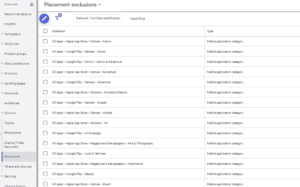
Tip: if you can’t see the content tab, it’s likely as you haven’t run a display campaign in the account before. Create a dummy display campaign and pause it. You should then be able to add placement exclusions.
Performance max hack 3 – Add negative keywords
A legacy frustration those who use smart shopping will be familiar with, is the lack of ability to see or exclude keywords. Performance max does offer some insights into keywords triggering in the insights tab but it’s not clear if you’re able to negate keywords. Whilst you can’t do it yourself in the interface, you can contact your google account manager or google support to apply negatives to campaigns.
It might be that your campaign performance is looking amazing, but you’re only triggering brand terms or keywords already covered in your search campaigns. Or it could be that you’ve seen your ad triggering for keywords that aren’t relevant. You can compile a list and send it off to the Google team to implement the negatives for you. As it’s not the most efficient way to have to go through another party, we recommend spending some time collating a list and sending it over in one go.
Performance hack 4 – Budget
We’ve tested performance max on a range of clients with varying budgets. The most successful have been the ones that have spent £75+ a day for a consistent amount of time. The most inconsistent performance has been from budgets smaller than this with large spikes in impressions one week and a huge drop the next. As performance max is a fully automated campaign type, it needs to generate enough data and learning for each format to work most efficiently for your business goals so consider the budget before launching a performance max campaign.
Performance hack 5 – Landing page placements
While not available as a report yet in Google Ads, you can use Google Analytics to see where the campaign type is sending traffic (especially if you have URL expansion enabled on the campaign). To do this, navigate to Google Analytics > landing pages > add a secondary dimension for campaign and filter to whatever your naming convention is for performance max campaigns. Here, you’ll be able to see where the campaign is actually sending traffic. From here you can decide to either exclude URLs or consider turning URL expansion off.
Performance hack 6 – Location Settings
Hidden in a small drop menu, there is a setting for location options. Here the default is selected to presence or interest which is recommended from Google. With this enabled though and United Kingdom as the campaign targeting, your ads are still able to serve in other countries. We recommend changing to only presence to ensure you are only serving people physically within your targeted location.
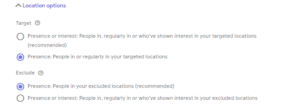
Performance hack 7 – Ad scheduling
The switch from standard shopping to smart shopping saw the removal of ad scheduling as well as negatives. This meant advertisers were unable to specify when their ads showed and had to fully give into the power of AI to decide the best days weeks and times to show ads. With performance max, you can add ad scheduling again so you can choose which days of the week and hours to show ads.
We have a couple of B2B clients who see much poorer performance on their shopping ads over weekends, so this has been hugely crucial in being able to pull back on spending over these days and concentrate more on weekdays when conversion and ROAS is stronger.
Performance hack 8 – Performance Planner
Performance planner is a tool within the Google Ads interface to help forecast performance with increases or decreases in spending. If you are an e-commerce business using performance max, then you can now use performance planner to forecast performance for your campaigns.
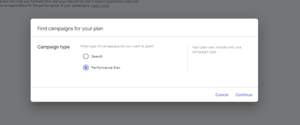
As with everything Google Ads, the campaigns and functionality are constantly evolving so it may be there is more freedom to optimise campaigns in future (we’re hoping for a succinct report on channel placements in future!) If you’re curious about performance max or struggling with current performance on your PPC campaigns, then get in touch with our team today.

